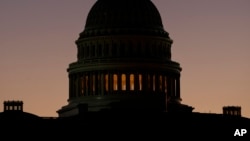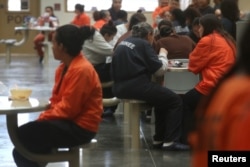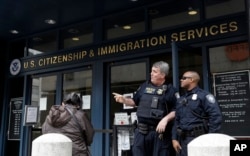As congressional negotiators reconvened Monday on Capitol Hill to craft a bipartisan budget deal in hopes of avoiding a second government shutdown this year, officials from both parties scrambled to handle the latest immigration obstacle in Washington.
The focus in recent days shifted away from billions of dollars in wall funding sought by President Donald Trump and toward the number of detention beds Congress is willing to fund, a request by Democratic lawmakers looking to rein in the administration's immigrant detention rate and overspending by immigration officials.
As of Sunday, the agency had 48,747 immigrants in custody on a variety of charges, from those who were charged or convicted in criminal courts to those whose offenses are civil immigration issues.
However, the agency is only funded for a daily average of 40,520 detainees.
U.S. Immigration and Customs Enforcement (ICE) is tasked with so-called "interior enforcement" — the apprehension and removal of immigrants, undocumented or otherwise, who are subject to deportation. That group accounts for part of the average number of detention beds needed every day. However, some of that population comes from transfers from U.S. Customs and Border Protection (CBP).
The current impasse on Capitol Hill is over the former, which Democrats propose to fund at a rate of 16,500 adults per day until the end of the fiscal year on Sept. 30. A senior ICE official said Monday that somewhere from 20,000 to 22,000 detainees in ICE custody right now are being held as a result of an ICE arrest and are subject to mandatory detention.
Overall, including the ICE arrestees and transfers from CBP, Democrats are seeking an average daily population in ICE detention of 35,520 for the remainder of FY19 — 34,000 adult beds and 1,250 family beds. The party's budget proposal issued at the end of January indicated this was on par with the daily average during the last three months of the Obama administration.
Detention alternatives
ICE has options for immigrants facing deportation who don't require "mandatory detention." For the last several years, the agency has asked for an increasing amount of money to boost its Alternatives to Detention program from 53,000 participants to 82,000.
These alternatives apply for people who "may pose a flight risk, but who are not considered a threat to our communities," in ICE's description.
Options for "intensive supervision" include "home visits, office visits, alert response, court tracking, and electronic monitoring" (such as ankle bracelets), according to the agency.
Matt Albence, the deputy director of U.S. Immigration and Customs Enforcement, spoke about the president's request for 52,000 detention beds.
"Ankle monitors and alternatives to detention are woefully ineffective at effectuating removals from the United States," Albence said Monday on a call with reporters. "Detention is the only proven effective method to ensure that the individual ordered removed is actually removed."
Albence accused lawmakers of "trying to abolish ICE ... through the fiduciary process" with the proposed cap.
Speaking in Congress on Monday, shortly before the conference committee reconvened to discuss the budget disagreements, Senate Majority Leader Mitch McConnell similarly decried the Democrats' cap, calling it a "get-out-of-jail-free card for criminals because the radical left doesn't like U.S. Immigration and Customs Enforcement."
ICE opposition
But Democrats aren't the only ones trying to limit ICE spending. Under a Republican-led Senate last June, the Appropriations committee — which included McConnell — issued a report noting that it discouraged shifting funds from other areas to cover the agency's overspending, "in light of the Committee's persistent and growing concerns about ICE's lack of fiscal discipline, whether real or manufactured, and its inability to manage detention resources within the appropriations."
On a call with reporters Monday, Mary Small, policy director for Detention Watch Network, which aims to end immigration detention, said ICE's "massive detention expansion spree" in recent years — from roughly 34,000 people a day in custody to nearly 50,000 last week — is at the root of a problem that comes down to a "violation of basic good governance standards."
"The reason that negotiators are pushing for a limitation on detention is precisely because of this three-year history of bad behavior," Small said. "[E]ven after being repeatedly warned by appropriators … they've continued to overspend."
Also on the call was Angel Padilla, a policy director for Indivisible, who said the detention issue under the Trump administration is about more than funding. According to its website, Indivisible is a group formed to "resist the Trump agenda."
"What we've seen over the last two years is that Trump and his administration have basically just targeted and been at war with immigrants and people of color," said Padilla, listing the travel bans, cuts to immigrant programs, and the administration's family separation policy as examples of policies targeting minority groups.
"It is clear that what this administration wants is to jail and deport as many brown people as possible, and as many immigrants [as possible]," he added.
Federal lawmakers have until the end of Friday to reach an agreement — one that stands a chance of being approved by the president — or the country will witness a partial government shutdown again.
The most recent one lasted 35 days, during which hundreds of thousands of federal employees went without pay. It ended with a stopgap budget measure Jan. 25, but that deal expires at 12:01 a.m. Feb. 16.
VOA's Michael Bowman contributed to this report.










